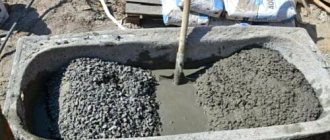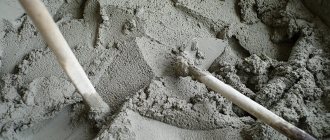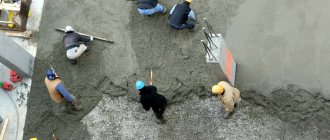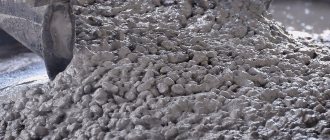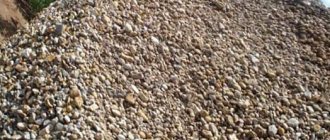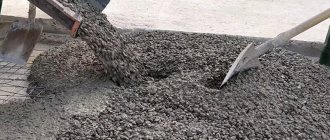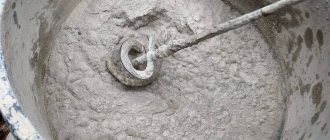Mixing the solution in a concrete mixer is quick and convenient. Light and heavy construction mixtures are prepared in it. To prepare high-quality concrete, you need to know the proportions of the components, the sequence of their loading, requirements for installation and the start of work. The process should be carried out strictly according to technology, taking into account the permissible time of continuous operation and the productivity of the unit.
Main components and proportions of the mixture
The main components for the production of concrete mixtures are cement (C), sand (S), crushed stone (SH), water (W), and auxiliary additives. The performance characteristics of concrete depend on their quality and quantity. They focus on this ratio of ingredients depending on the brand of concrete (the larger the number in the marking, the higher the strength of the solution):
- for M200 the proportions C:P:SH are 1:3:5;
- M300 - 1:2:3.5;
- M400 - 1:1,3:3;
- M450 - 1:1.1:2.5.
The volume of water consumed to prepare the mixture is determined from the ratio of 0.6-1.15 parts of water to 1 part of cement. The higher the strength required, the less water is added.
To mix concrete at the household level, the quantity of components is measured in buckets with a volume of 10-12 liters. For example, you can calculate the proportions of concrete components in buckets for pouring a foundation using the table.
| Concrete grade | Purpose | Cement | Sand | Crushed stone |
| M100 | Pouring concrete bases, foundations for fences, garages, outbuildings | 10 | 32 | 50 |
| M200 | Foundation of one- and two-story houses with light floors | 10 | 25 | 42 |
| M300 | Foundation of cottages up to 5 floors high; monolithic floors | 10 | 19 | 34 |
| M400 | Construction of buildings up to 20 floors high | 10 | 11 | 24 |
Cement
Cement acts as the main binder in concrete and affects its physical properties. The role of the cement binder is to form a mortar matrix, which serves to evenly distribute the load between large and small filler particles.
The composition of cement includes:
- 50-70% alite - this substance provides short-term strength;
- 15-30% white - affects the strength properties of concrete throughout the entire service life;
- aluminates, aluminoferrites - determine the speed of setting when cement comes into contact with water.
To prepare concrete, cement grades from M200 to M500 (sometimes M600) are used. The numbers in the marking correspond to the minimum compressive strength in kg/cm2.
The quality of cement is determined by its shelf life. It is advisable that it be done no later than 3 months ago. When squeezed, it should not form lumps.
Crushed stone
Use crushed granite or gravel. It must be clean. Foreign objects and large pieces should be excluded.
Requirements for the size of granite crushed stone, depending on the purpose of using the solution:
- floor slabs - 5-10 mm;
- foundation for residential buildings - 5-20 mm, for industrial facilities - 20-40 mm;
Crushed gravel is used in the following fractional composition:
- construction and finishing works - 3-10 and 5-20 mm;
- foundation - 40-70 mm.
For the construction of private residential buildings, crushed stone with a particle size of 20-70 mm is usually used. It is introduced into concrete mortar as a coarse filler, which helps improve the strength characteristics of the mixture.
Sand
It is optimal to use clean river or quartz sand. The presence of clay particles in it worsens the properties of concrete. Therefore, choose coarse natural sand with a minimum content of small clay particles, grain size up to 3 mm. You can mix fine sand with higher quality coarse sand.
The purpose of using sand is to reduce cement consumption, fill pores between large fillers, and strengthen concrete.
Water
The water for mixing concrete should not contain dissolved salts, alkalis, or acids. They prevent the mixture from setting and hardening properly. Water cannot be used:
- sewage;
- contaminated with harmful impurities;
- containing plant matter that may decompose;
- which contain oils and organic impurities.
Concrete is mixed using tap drinking or industrial water. Fresh river, lake, rain, melt - used after settling. Salt water (sea or lake) can be used in dry and hot climates or if reinforcement is not used in the joints. Water from clay-bottomed wells is introduced after careful filtration.
Excipients
Auxiliary substances improve the properties of the concrete mixture. Add to the main ingredients:
- plasticizers to increase the viscosity or fluidity of concrete;
- slaked lime to simplify the laying of the composition;
- bridging additives for filling pores in the mixture with waterproof materials;
- reinforcing fibers (polypropylene) to improve strength characteristics;
- modifiers for rapid hardening of concrete mortar - when working in conditions of low temperatures, high humidity, and also when there is an excess of water in the mixture;
- air-entraining and gas-forming to increase the frost resistance and water resistance of concrete.
If it is expected that the work will be carried out for a long time, substances are added that slow down the setting process.
What is the best concrete mix ratio for general work?
This article will focus on mixing concrete for a general purpose B20 mix that is more than suitable for garden paths, concreting fences, shallow foundations for retaining walls, some foundations, shed foundations and many other domestic and commercial applications.
B20 is a medium strength concrete mixture. This means that it will achieve a strength equivalent to a compressive strength of 20 Newtons per square mm after 28 days. More information about the types and strengths of concrete and how they should be used can be found below.
This mixture is not suitable for foundation construction. To do this, please read our article on foundations.
If you are planning any major renovation or construction project, your designer will likely determine the concrete strength required for your project. If you are not at all sure about the strength of the concrete mixture you should use, consult a specialist!
Equipment installation and safety precautions
Before starting work, the concrete mixer is properly installed to ensure uniform mixing of materials. It is necessary to ensure its perfectly level position and securely fasten it. To do this, the unit is placed on a horizontal area. If there is no such surface at the construction site, you can organize it using a level, boards and available materials.
During the first batch, it is recommended to add 10% more cement and sand to the mixture than was calculated according to the proportion. This serves as a correction for the adhesion of these components to the propeller blades. You can additionally lubricate the screw.
Be sure to wear safety glasses, gloves and follow safety precautions:
- make sure that there are no dangerous factors at the installation site of the concrete mixer;
- check that the unit is installed correctly;
- check the presence of switching equipment and grounding devices;
- provide a passage to the installation with a width of at least 1 m;
- monitor the serviceability of mechanisms during operation;
- do not insert a shovel or put your hands into a moving drum;
- Do not lean too low over the drum.
Work related to the inspection and maintenance of the concrete mixer is not done with the mechanism drives turned on. If malfunctions are detected or current appears on the housing, the mixer is turned off and work is stopped.
Cooking by hand
Preparation of concrete by hand. There are two types of manual kneading:
- Cement is added to a container with water in a certain proportion. The consistency is thoroughly mixed and filler and sand are poured into it. Mix the mixture thoroughly again until smooth;
- Dry ingredients are mixed in a container. A depression is created in the center into which water is poured. Mixing occurs gradually from the edges to the center. It is necessary to constantly monitor the plasticity of the mixture by adding water.
The procedure goes as follows:
- pour the required amount of sand into a metal box or onto tin sheets 2x2 m;
- add the required volume of Portland cement depending on the brand of concrete and its purpose;
- after thoroughly mixing the components, add water and filler depending on the proportions drawn up for a specific construction;
- Repeated mixing with a shovel until the resulting mixture reaches a uniform consistency and is free of lumps.
Loading order
To obtain a high-quality mixture and prevent mechanical damage to the drum, its components are loaded in the following sequence: cement, sand, crushed stone, water. To correctly load all components into a concrete mixer, adhere to the following algorithm of actions:
- Pour some water into the drum. This will reduce the adhesion of the mixture components to the walls and blades.
- Cement is poured.
- Turn on the concrete mixer and stir until a viscous homogeneous mixture is formed.
- Add sand into the drum, add water, and continue stirring.
- Gravel or crushed stone is laid and auxiliary substances are added.
Some recommend this loading order: first mix all the dry ingredients, pour them into a concrete mixer, and add water. But this loading method complicates mixing of concrete.
How much sand and cement, crushed stone and water should I take?
What is concrete?
Concrete is a mixture of cement, sand (fine aggregate), small stone or gravel (coarse aggregate) and water. It has many uses, from fencing to highway foundations, and because of this, there are many different concrete mix ratios that the components can be mixed with each, resulting in different concrete strengths.
As for concrete mixtures of different strengths, they range from B10 to B40, with B10 being less strong and B40 being stronger.
Main process
Concrete produced in a concrete mixer has higher quality indicators compared to mortar mixed with your own hands. In addition, the labor intensity and duration of the process are reduced.
A solution is prepared in a concrete mixer using the following technology:
- The component composition is selected and the proportions of materials are calculated.
- Prepare the fillers. If necessary, they are sifted, washed, and dried. Water, if necessary, is settled.
- Gradually, taking into account the density, load the components into the mixer and add water.
- Add excipients.
- After loading the inert materials, they begin to knead them.
- Check the readiness of the mixture. To do this, make several notches with a shovel on the surface of the solution. The finished mixture has a smooth surface with preservation of peaks between the notches. The consistency of the finished solution is cheesy, but quite plastic.
- Unload the mixture. It is convenient to use a metal bath or trough.
- Clean the concrete mixer and equipment.
Before filling in a new batch of solution components, remove the remnants of the finished mixture. To do this, clean water (5-7 l) is poured into the drum, to which sand is added. After draining, it can be used to knead the next batch of mixture.
Delivery
To deliver the finished solution to the construction site, it is best to use polymer buckets.
Preparing the solution is the beginning of the work. It still needs to be delivered to the place of use. In domestic conditions, ordinary buckets are most often used for this purpose. It is not recommended to use galvanized ones: their handles quickly become unusable. Such buckets are very difficult to clean; the solution on their walls accumulates more and more each time. It is better to use polymer buckets. Containers from ready-made putty performed especially well. They can last for several years without losing their shape or breaking the handles. Their volume is usually 17 liters. They have a reliable and durable design, are made of high-quality material, the solution does not stick to them, they are easy to clean, and also have very comfortable metal handles.
How long does it take to mix concrete in a concrete mixer?
The time during which the solution must be mixed in a concrete mixer depends on its design and engine power. All these indicators are given in the operating instructions.
The duration of continuous operation without engine overload, depending on the type of concrete mixer, is:
- gravity - 2-2.5 minutes;
- forced type - 1-2 min.
Time is counted from the moment when all the ingredients have been loaded into the mixer drum. Prolonged mixing of concrete is not recommended. This is accompanied by evaporation of water and, accordingly, a decrease in its plasticity characteristics.
We calculate the required quantity
Calculating the required amount of raw materials is not difficult. In this case, the problem is how to properly mix concrete in a concrete mixer, using a bucket for measurement; there is no need to use a bucket. How much concrete can be produced by mixing a standard volume of components?
For example, to obtain one cubic meter of solution, the following ratio of components in buckets must be observed: 2 buckets of cement, 5 buckets of sand, 9 buckets of crushed stone and water, as needed. If there is a need for a large volume of the mixture. For example, in order to pour the foundation immediately, and not in stages, you need to order a ready-made solution, which will be delivered in a mixer on a KAMAZ chassis.
How much concrete can you mix with a concrete mixer in a day?
The yield of solution per day prepared in a concrete mixer depends on:
- drum volume, for household and semi-industrial purposes mixers with a capacity from 45-60 l to 120, 160, 180 l are used;
- engine power;
- time of mixing and unloading of the mixture;
- number of batches that can be prepared within an hour.
The amount of concrete that can be mixed with one device during a working day is determined in the following sequence:
- Calculate the total duration of the working cycle. To do this, sum up the time allotted for loading, mixing, and unloading.
- Determine how many times per hour the kneading can be done by dividing 60 by the duration of the working cycle.
- Find the amount of material that can be prepared in 1 hour (m3/hour). To do this, the volume of the drum is multiplied by the number of kneading cycles. It is taken into account that the finished mixture occupies 40-60% of its volume.
- Multiply the number of permissible hours of work per day by the hourly productivity.
This method of determining daily productivity is used for both gravity and forced concrete mixers. In gravity-type models, 60-500 liters of solution are produced at one time, depending on the volume of the drum.
Proper operation of the concrete mixer, compliance with the proportions of fillers and water, and compliance with safety requirements guarantee the production of a high-quality concrete solution. There are advantages to preparing concrete in a concrete mixer. They are to increase productivity and reduce the labor intensity of the process.
Requirements for materials used
To prepare concrete, the following materials are needed:
Portland cement grades range from 300 to 500; the higher the grade, the less quantity will be required to obtain the desired grade. When purchasing material, it is important to take into account the following nuances: production time and quality characteristics of cement during storage during the year are reduced by 2 times; storage conditions, the material must be crumbly without lumps and not damp; the bags must be marked with the date of manufacture, brand and percentage of additives or their absence; It is recommended to purchase M400 cements.
Crushed stone fractions ≤ 20 mm. It is desirable to have a minimum number of larger elements that impair the mixing of the mixture and the ease of placement. The best quality products are provided by granite, less gravel and the lowest limestone types of crushed stone. The greatest strength is provided by cuboid-shaped particles; a smooth shape impairs the strength properties of solutions
The absence of dirt and dust is important, so it is recommended to clean the material by sifting through fine mesh and remove dust by washing. To reduce the volumetric weight, expanded clay with a particle size of up to 5 mm is often used instead of crushed stone.
The sand used is quarry sand, not river sand. The first is larger in size, but contains clay impurities, so the sand must be sifted or washed before use; the presence of pieces of clay ≥ 3 cm, plant particles, silt, rocky and glass inclusions, dust is unacceptable
The sand must be dry, humidity ≤ 1% is acceptable. P Water that does not contain organic impurities, acids, oils and alkalis. Without performing laboratory quality tests, it is recommended to use drinking water. Special additives: plasticizing, antifreeze and a number of others.
When purchasing ready-made dry mixes, which are widely available on the market, you need to pay attention to the presence of additives in their composition, what they affect and strictly follow the recommendations for the amount of mixing water
Nuances
By observing the proportions in the buckets of the concrete composition for the foundation, you can achieve impeccable quality of the finished product. Based on 1 cubic meter of solution, it is necessary to add the indicated components in the following quantities: Ts2:P5:S9.
When constructing not very tall frame buildings, a columnar type foundation is used, which does not require special super-strength mortar. Preparation of a cement mixture, when the measuring material is a bucket, is relevant:
- If necessary, perform minor work;
- In the process of gradually pouring the foundation;
- When there is no possibility of using special equipment at a construction site;
- Remote distance from enterprises involved in the manufacture and supply of the finished composition.
Which concrete mixer to choose for a summer house or construction site?
Specialized equipment has a wide range of applications: used in the construction process, performing household tasks (for example, building a blind area), reconstructing steps or a fence, etc.
The main task of concrete mixers is to uniformly mix all solid, bulk and liquid ingredients to obtain the finished building material. Thus, the construction process is significantly accelerated and the need for labor is reduced. Since the modern market offers concrete mixers
with different functionality, the main selection criterion will be the volume of concrete mixture that needs to be obtained.
